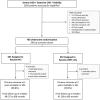Arrhythmia and Death Following Percutaneous Revascularization in Ischemic Left Ventricular Dysfunction: Prespecified Analyses From the REVIVED-BCIS2 Trial
- PMID: 37555345
- PMCID: PMC10487377
- DOI: 10.1161/CIRCULATIONAHA.123.065300
Arrhythmia and Death Following Percutaneous Revascularization in Ischemic Left Ventricular Dysfunction: Prespecified Analyses From the REVIVED-BCIS2 Trial
Abstract
Background: Ventricular arrhythmia is an important cause of mortality in patients with ischemic left ventricular dysfunction. Revascularization with coronary artery bypass graft or percutaneous coronary intervention is often recommended for these patients before implantation of a cardiac defibrillator because it is assumed that this may reduce the incidence of fatal and potentially fatal ventricular arrhythmias, although this premise has not been evaluated in a randomized trial to date.
Methods: Patients with severe left ventricular dysfunction, extensive coronary disease, and viable myocardium were randomly assigned to receive either percutaneous coronary intervention (PCI) plus optimal medical and device therapy (OMT) or OMT alone. The composite primary outcome was all-cause death or aborted sudden death (defined as an appropriate implantable cardioverter defibrillator therapy or a resuscitated cardiac arrest) at a minimum of 24 months, analyzed as time to first event on an intention-to-treat basis. Secondary outcomes included cardiovascular death or aborted sudden death, appropriate implantable cardioverter defibrillator (ICD) therapy or sustained ventricular arrhythmia, and number of appropriate ICD therapies.
Results: Between August 28, 2013, and March 19, 2020, 700 patients were enrolled across 40 centers in the United Kingdom. A total of 347 patients were assigned to the PCI+OMT group and 353 to the OMT alone group. The mean age of participants was 69 years; 88% were male; 56% had hypertension; 41% had diabetes; and 53% had a clinical history of myocardial infarction. The median left ventricular ejection fraction was 28%; 53.1% had an implantable defibrillator inserted before randomization or during follow-up. All-cause death or aborted sudden death occurred in 144 patients (41.6%) in the PCI group and 142 patients (40.2%) in the OMT group (hazard ratio, 1.03 [95% CI, 0.82-1.30]; P=0.80). There was no between-group difference in the occurrence of any of the secondary outcomes.
Conclusions: PCI was not associated with a reduction in all-cause mortality or aborted sudden death. In patients with ischemic cardiomyopathy, PCI is not beneficial solely for the purpose of reducing potentially fatal ventricular arrhythmias.
Registration: URL: https://www.
Clinicaltrials: gov; Unique identifier: NCT01920048.
Keywords: arrhythmias, cardiac; cardiomyopathies; death, sudden, cardiac; defibrillators, implantable; heart failure; myocardial revascularization; percutaneous coronary intervention.
Conflict of interest statement
Figures




Comment in
-
In ischemic LV dysfunction, adding PCI to medical therapy did not reduce a composite of death or aborted sudden death.Ann Intern Med. 2023 Nov;176(11):JC122. doi: 10.7326/J23-0088. Epub 2023 Nov 7. Ann Intern Med. 2023. PMID: 37931266
References
-
- Gräni C, Benz DC, Gupta S, Windecker S, Kwong RY. Sudden cardiac death in ischemic heart disease: from imaging arrhythmogenic substrate to guiding therapies. JACC Cardiovasc Imaging. 2020;13:2223–2238. doi: 10.1016/j.jcmg.2019.10.021 - PubMed
-
- Ryan M, Morgan H, Petrie MC, Perera D. Coronary revascularisation in patients with ischaemic cardiomyopathy. Heart. 2021;107:612–618. doi: 10.1136/heartjnl-2020-316856 - PubMed
-
- National Institute for Health and Care Excellence. Implantable cardioverter defibrillators and cardiac resynchronisation therapy for arrhythmias and heart failure. Technology appraisal guidance [TA314]. June 25, 2014. Accessed May 6, 2023. https://www.nice.org.uk/guidance/ta314
-
- Canty JM, Suzuki G, Banas MD, Verheyen F, Borgers M, Fallavollita JA. Hibernating myocardium: chronically adapted to ischemia but vulnerable to sudden death. Circ Res. 2004;94:1142–1149. doi: 10.1161/01.RES.0000125628.57672.CF - PubMed
-
- Russo AM, Stainback RF, Bailey SR, Epstein AE, Heidenreich PA, Jessup M, Kapa S, Kremers MS, Lindsay BD, Stevenson LW. ACCF/HRS/AHA/ASE/HFSA/SCAI/SCCT/SCMR 2013 appropriate use criteria for implantable cardioverter-defibrillators and cardiac resynchronization therapy: a report of the American College of Cardiology Foundation Appropriate Use Criteria Task Force, Heart Rhythm Society, American Heart Association, American Society of Echocardiography, Heart Failure Society of America, Society for Cardiovascular Angiography and Interventions, Society of Cardiovascular Computed Tomography, and Society for Cardiovascular Magnetic Resonance. Heart Rhythm. 2013;10:e11–e58. doi: 10.1016/j.hrthm.2013.01.008 - PubMed
Publication types
MeSH terms
Associated data
Grants and funding
LinkOut - more resources
Full Text Sources
Medical
Miscellaneous

